Nursing Pathophysiology/Pharmacology
VerifiedAdded on 2023/06/15
|9
|2253
|354
AI Summary
This article provides answers to nursing pathophysiology and pharmacology questions related to arteriosclerosis, NSTEMI, STEMI, angina pectoris, preload, afterload, hypertension, AV node abnormalities, and heart failure. It also includes drug cards for nitroglycerin and digoxin.
Contribute Materials
Your contribution can guide someone’s learning journey. Share your
documents today.
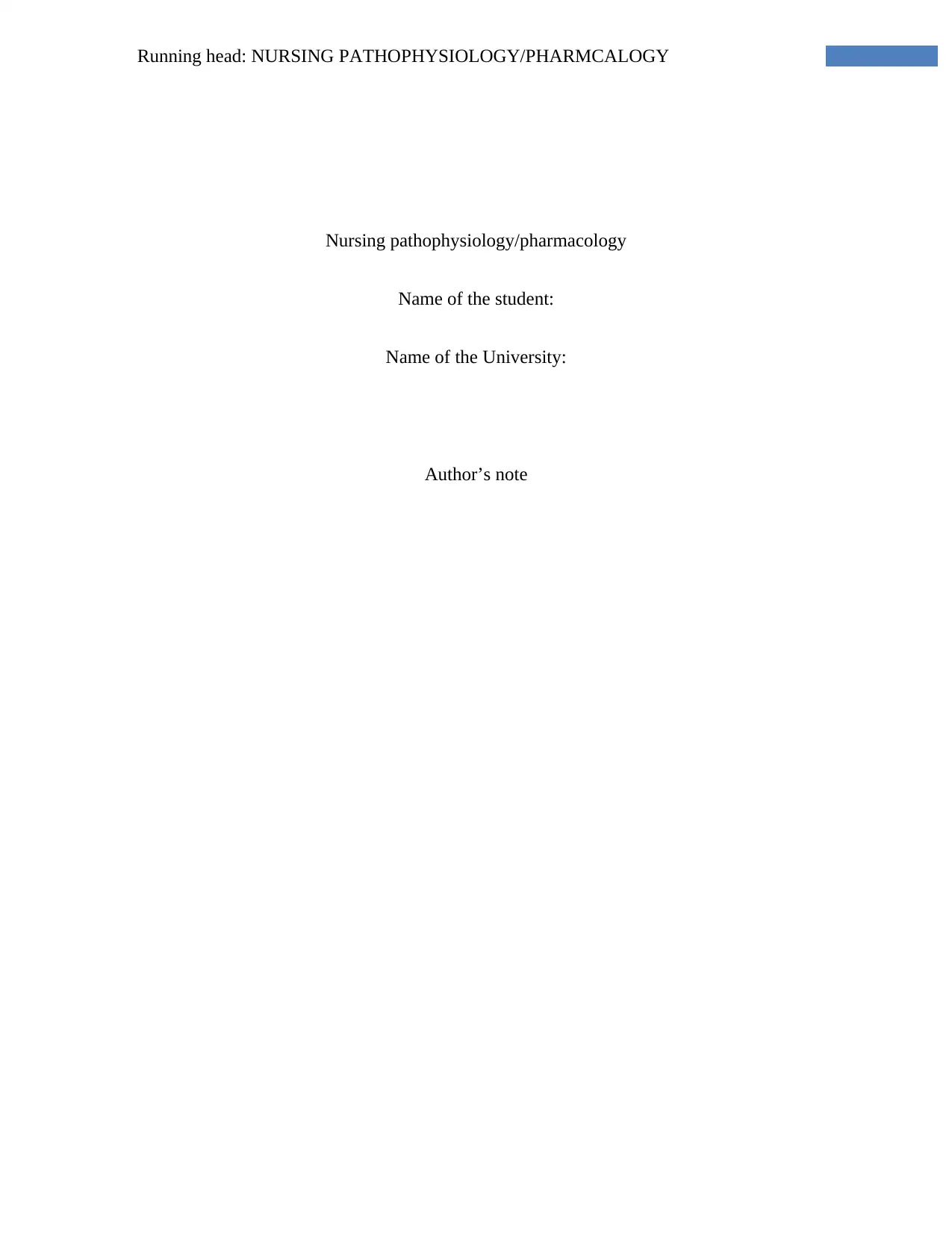
Running head: NURSING PATHOPHYSIOLOGY/PHARMCALOGY
Nursing pathophysiology/pharmacology
Name of the student:
Name of the University:
Author’s note
Nursing pathophysiology/pharmacology
Name of the student:
Name of the University:
Author’s note
Secure Best Marks with AI Grader
Need help grading? Try our AI Grader for instant feedback on your assignments.
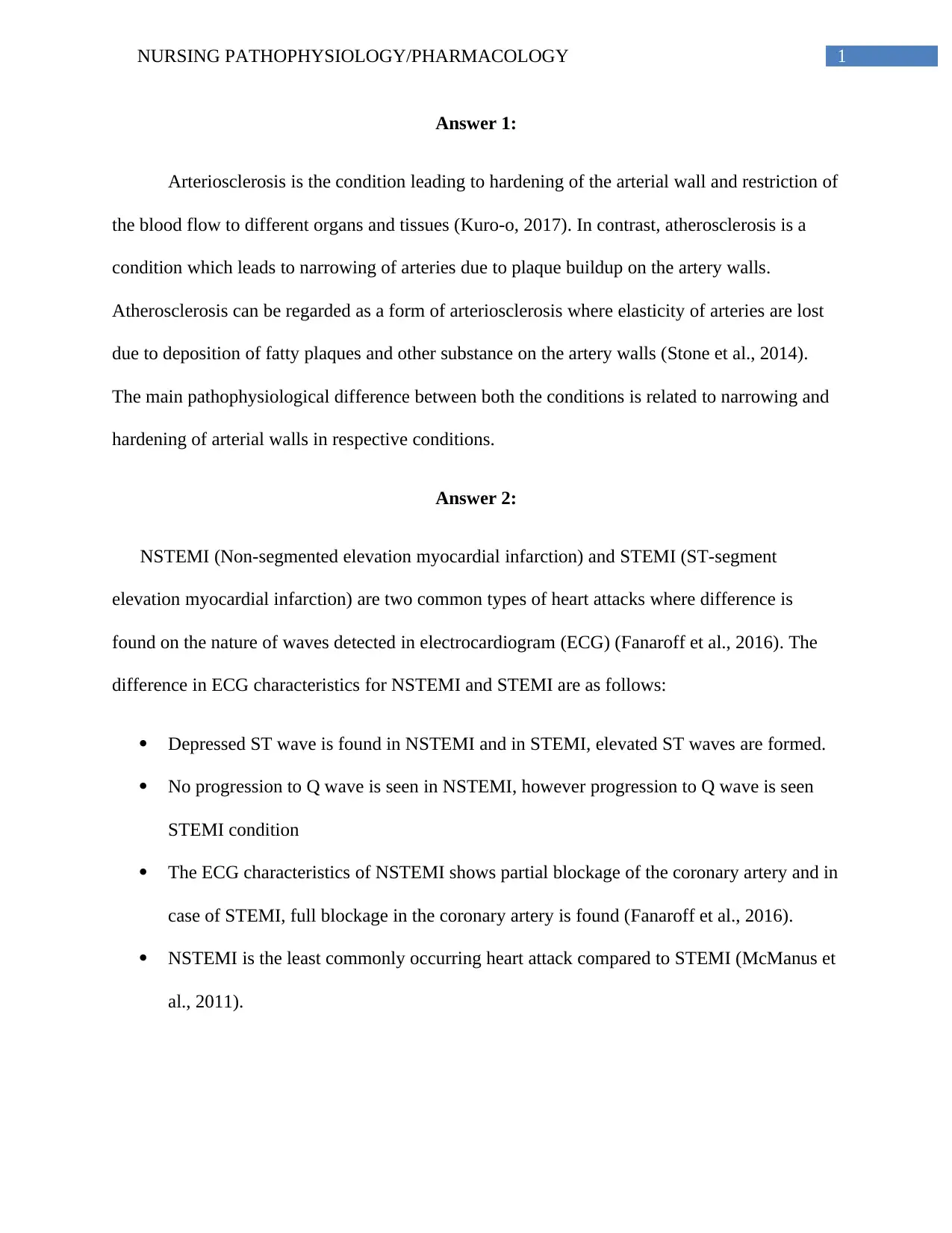
1NURSING PATHOPHYSIOLOGY/PHARMACOLOGY
Answer 1:
Arteriosclerosis is the condition leading to hardening of the arterial wall and restriction of
the blood flow to different organs and tissues (Kuro-o, 2017). In contrast, atherosclerosis is a
condition which leads to narrowing of arteries due to plaque buildup on the artery walls.
Atherosclerosis can be regarded as a form of arteriosclerosis where elasticity of arteries are lost
due to deposition of fatty plaques and other substance on the artery walls (Stone et al., 2014).
The main pathophysiological difference between both the conditions is related to narrowing and
hardening of arterial walls in respective conditions.
Answer 2:
NSTEMI (Non-segmented elevation myocardial infarction) and STEMI (ST-segment
elevation myocardial infarction) are two common types of heart attacks where difference is
found on the nature of waves detected in electrocardiogram (ECG) (Fanaroff et al., 2016). The
difference in ECG characteristics for NSTEMI and STEMI are as follows:
Depressed ST wave is found in NSTEMI and in STEMI, elevated ST waves are formed.
No progression to Q wave is seen in NSTEMI, however progression to Q wave is seen
STEMI condition
The ECG characteristics of NSTEMI shows partial blockage of the coronary artery and in
case of STEMI, full blockage in the coronary artery is found (Fanaroff et al., 2016).
NSTEMI is the least commonly occurring heart attack compared to STEMI (McManus et
al., 2011).
Answer 1:
Arteriosclerosis is the condition leading to hardening of the arterial wall and restriction of
the blood flow to different organs and tissues (Kuro-o, 2017). In contrast, atherosclerosis is a
condition which leads to narrowing of arteries due to plaque buildup on the artery walls.
Atherosclerosis can be regarded as a form of arteriosclerosis where elasticity of arteries are lost
due to deposition of fatty plaques and other substance on the artery walls (Stone et al., 2014).
The main pathophysiological difference between both the conditions is related to narrowing and
hardening of arterial walls in respective conditions.
Answer 2:
NSTEMI (Non-segmented elevation myocardial infarction) and STEMI (ST-segment
elevation myocardial infarction) are two common types of heart attacks where difference is
found on the nature of waves detected in electrocardiogram (ECG) (Fanaroff et al., 2016). The
difference in ECG characteristics for NSTEMI and STEMI are as follows:
Depressed ST wave is found in NSTEMI and in STEMI, elevated ST waves are formed.
No progression to Q wave is seen in NSTEMI, however progression to Q wave is seen
STEMI condition
The ECG characteristics of NSTEMI shows partial blockage of the coronary artery and in
case of STEMI, full blockage in the coronary artery is found (Fanaroff et al., 2016).
NSTEMI is the least commonly occurring heart attack compared to STEMI (McManus et
al., 2011).
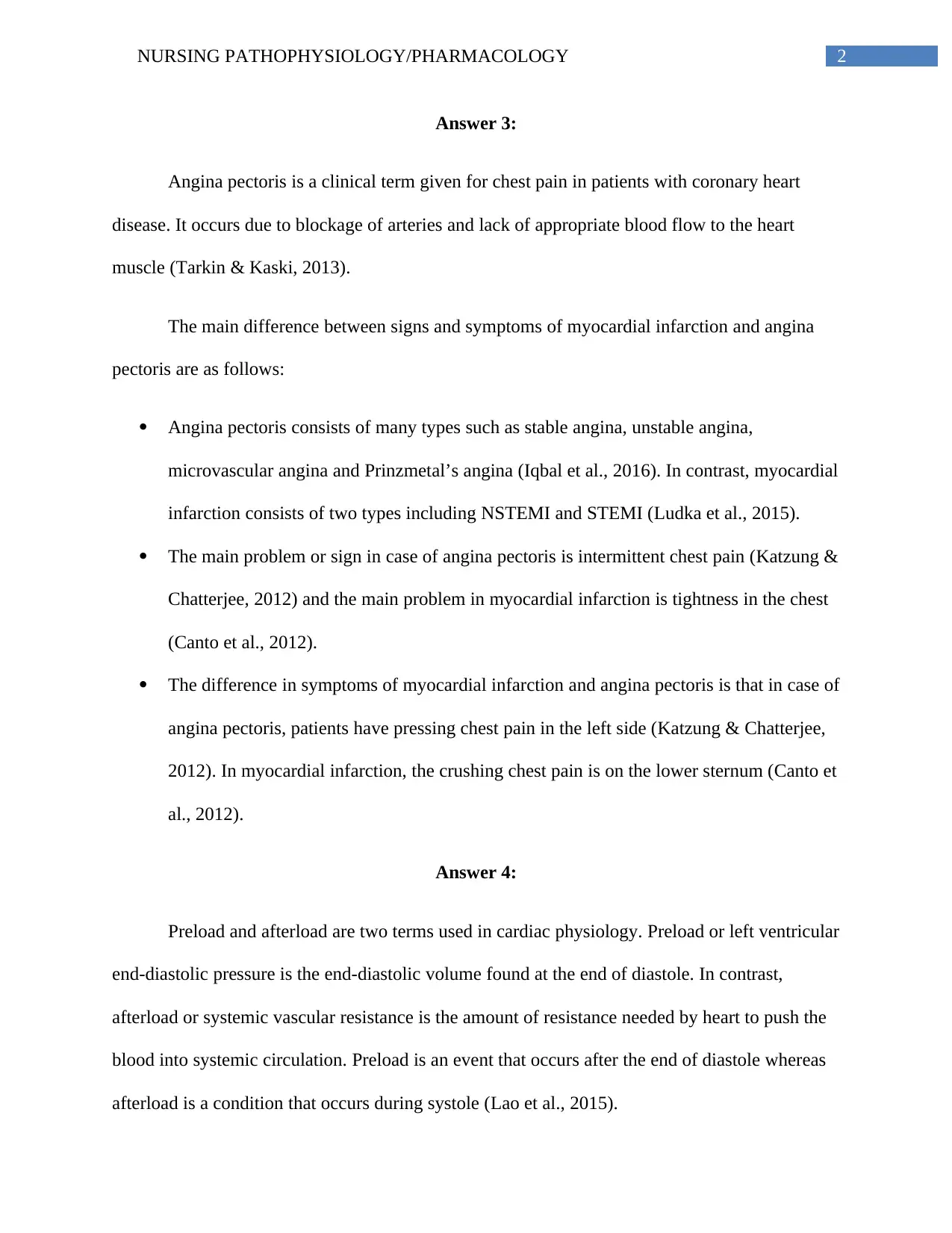
2NURSING PATHOPHYSIOLOGY/PHARMACOLOGY
Answer 3:
Angina pectoris is a clinical term given for chest pain in patients with coronary heart
disease. It occurs due to blockage of arteries and lack of appropriate blood flow to the heart
muscle (Tarkin & Kaski, 2013).
The main difference between signs and symptoms of myocardial infarction and angina
pectoris are as follows:
Angina pectoris consists of many types such as stable angina, unstable angina,
microvascular angina and Prinzmetal’s angina (Iqbal et al., 2016). In contrast, myocardial
infarction consists of two types including NSTEMI and STEMI (Ludka et al., 2015).
The main problem or sign in case of angina pectoris is intermittent chest pain (Katzung &
Chatterjee, 2012) and the main problem in myocardial infarction is tightness in the chest
(Canto et al., 2012).
The difference in symptoms of myocardial infarction and angina pectoris is that in case of
angina pectoris, patients have pressing chest pain in the left side (Katzung & Chatterjee,
2012). In myocardial infarction, the crushing chest pain is on the lower sternum (Canto et
al., 2012).
Answer 4:
Preload and afterload are two terms used in cardiac physiology. Preload or left ventricular
end-diastolic pressure is the end-diastolic volume found at the end of diastole. In contrast,
afterload or systemic vascular resistance is the amount of resistance needed by heart to push the
blood into systemic circulation. Preload is an event that occurs after the end of diastole whereas
afterload is a condition that occurs during systole (Lao et al., 2015).
Answer 3:
Angina pectoris is a clinical term given for chest pain in patients with coronary heart
disease. It occurs due to blockage of arteries and lack of appropriate blood flow to the heart
muscle (Tarkin & Kaski, 2013).
The main difference between signs and symptoms of myocardial infarction and angina
pectoris are as follows:
Angina pectoris consists of many types such as stable angina, unstable angina,
microvascular angina and Prinzmetal’s angina (Iqbal et al., 2016). In contrast, myocardial
infarction consists of two types including NSTEMI and STEMI (Ludka et al., 2015).
The main problem or sign in case of angina pectoris is intermittent chest pain (Katzung &
Chatterjee, 2012) and the main problem in myocardial infarction is tightness in the chest
(Canto et al., 2012).
The difference in symptoms of myocardial infarction and angina pectoris is that in case of
angina pectoris, patients have pressing chest pain in the left side (Katzung & Chatterjee,
2012). In myocardial infarction, the crushing chest pain is on the lower sternum (Canto et
al., 2012).
Answer 4:
Preload and afterload are two terms used in cardiac physiology. Preload or left ventricular
end-diastolic pressure is the end-diastolic volume found at the end of diastole. In contrast,
afterload or systemic vascular resistance is the amount of resistance needed by heart to push the
blood into systemic circulation. Preload is an event that occurs after the end of diastole whereas
afterload is a condition that occurs during systole (Lao et al., 2015).
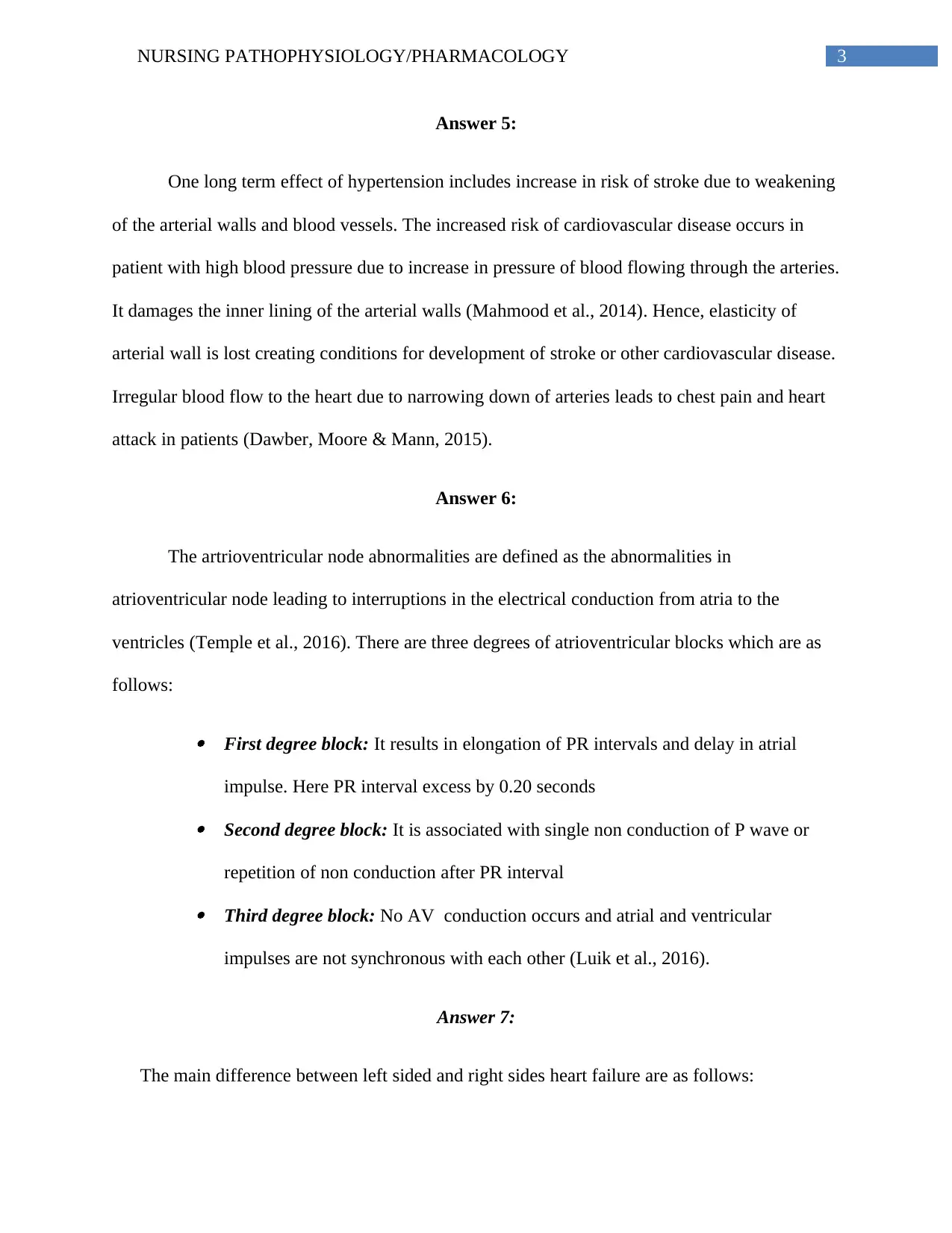
3NURSING PATHOPHYSIOLOGY/PHARMACOLOGY
Answer 5:
One long term effect of hypertension includes increase in risk of stroke due to weakening
of the arterial walls and blood vessels. The increased risk of cardiovascular disease occurs in
patient with high blood pressure due to increase in pressure of blood flowing through the arteries.
It damages the inner lining of the arterial walls (Mahmood et al., 2014). Hence, elasticity of
arterial wall is lost creating conditions for development of stroke or other cardiovascular disease.
Irregular blood flow to the heart due to narrowing down of arteries leads to chest pain and heart
attack in patients (Dawber, Moore & Mann, 2015).
Answer 6:
The artrioventricular node abnormalities are defined as the abnormalities in
atrioventricular node leading to interruptions in the electrical conduction from atria to the
ventricles (Temple et al., 2016). There are three degrees of atrioventricular blocks which are as
follows: First degree block: It results in elongation of PR intervals and delay in atrial
impulse. Here PR interval excess by 0.20 seconds
Second degree block: It is associated with single non conduction of P wave or
repetition of non conduction after PR interval
Third degree block: No AV conduction occurs and atrial and ventricular
impulses are not synchronous with each other (Luik et al., 2016).
Answer 7:
The main difference between left sided and right sides heart failure are as follows:
Answer 5:
One long term effect of hypertension includes increase in risk of stroke due to weakening
of the arterial walls and blood vessels. The increased risk of cardiovascular disease occurs in
patient with high blood pressure due to increase in pressure of blood flowing through the arteries.
It damages the inner lining of the arterial walls (Mahmood et al., 2014). Hence, elasticity of
arterial wall is lost creating conditions for development of stroke or other cardiovascular disease.
Irregular blood flow to the heart due to narrowing down of arteries leads to chest pain and heart
attack in patients (Dawber, Moore & Mann, 2015).
Answer 6:
The artrioventricular node abnormalities are defined as the abnormalities in
atrioventricular node leading to interruptions in the electrical conduction from atria to the
ventricles (Temple et al., 2016). There are three degrees of atrioventricular blocks which are as
follows: First degree block: It results in elongation of PR intervals and delay in atrial
impulse. Here PR interval excess by 0.20 seconds
Second degree block: It is associated with single non conduction of P wave or
repetition of non conduction after PR interval
Third degree block: No AV conduction occurs and atrial and ventricular
impulses are not synchronous with each other (Luik et al., 2016).
Answer 7:
The main difference between left sided and right sides heart failure are as follows:
Secure Best Marks with AI Grader
Need help grading? Try our AI Grader for instant feedback on your assignments.
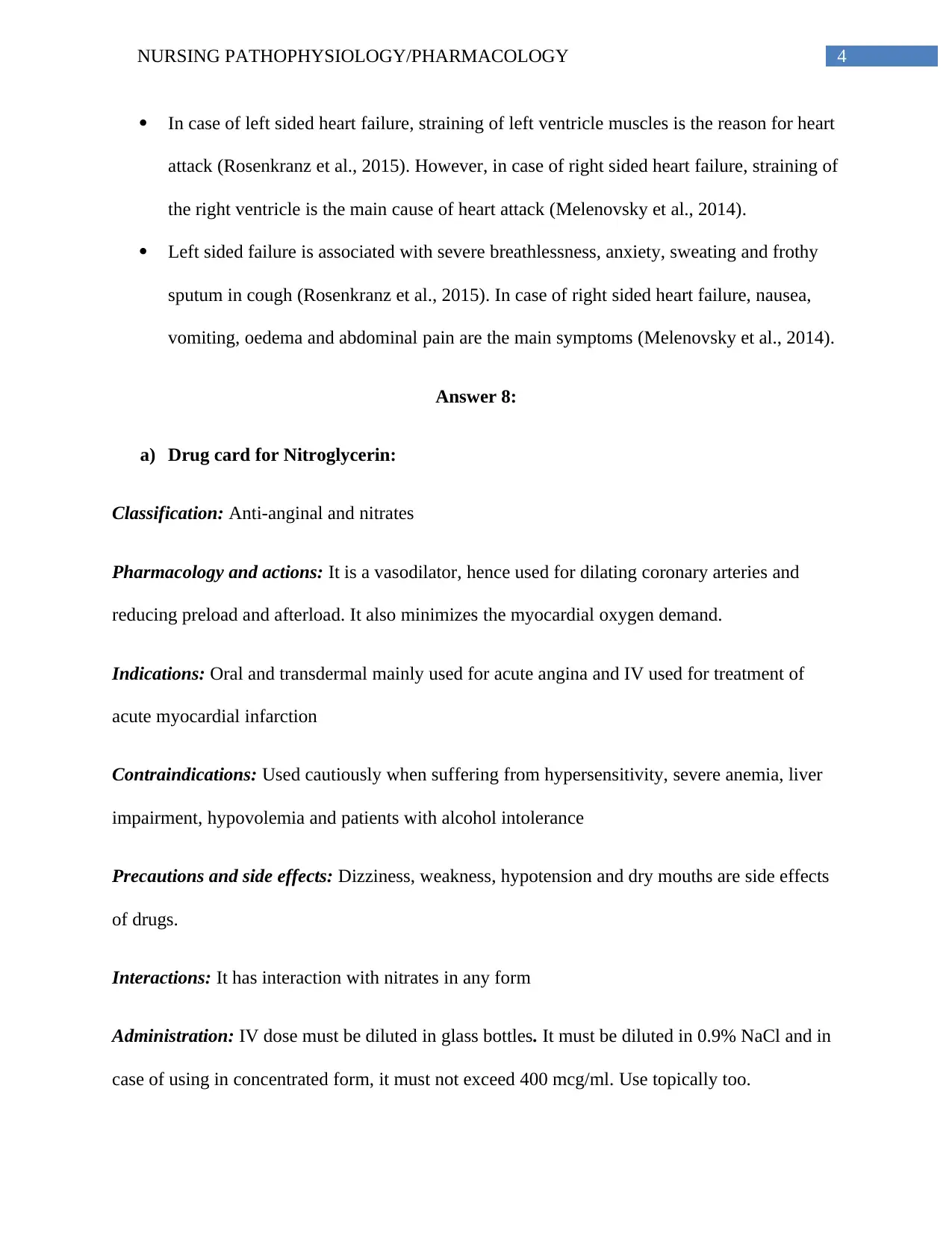
4NURSING PATHOPHYSIOLOGY/PHARMACOLOGY
In case of left sided heart failure, straining of left ventricle muscles is the reason for heart
attack (Rosenkranz et al., 2015). However, in case of right sided heart failure, straining of
the right ventricle is the main cause of heart attack (Melenovsky et al., 2014).
Left sided failure is associated with severe breathlessness, anxiety, sweating and frothy
sputum in cough (Rosenkranz et al., 2015). In case of right sided heart failure, nausea,
vomiting, oedema and abdominal pain are the main symptoms (Melenovsky et al., 2014).
Answer 8:
a) Drug card for Nitroglycerin:
Classification: Anti-anginal and nitrates
Pharmacology and actions: It is a vasodilator, hence used for dilating coronary arteries and
reducing preload and afterload. It also minimizes the myocardial oxygen demand.
Indications: Oral and transdermal mainly used for acute angina and IV used for treatment of
acute myocardial infarction
Contraindications: Used cautiously when suffering from hypersensitivity, severe anemia, liver
impairment, hypovolemia and patients with alcohol intolerance
Precautions and side effects: Dizziness, weakness, hypotension and dry mouths are side effects
of drugs.
Interactions: It has interaction with nitrates in any form
Administration: IV dose must be diluted in glass bottles. It must be diluted in 0.9% NaCl and in
case of using in concentrated form, it must not exceed 400 mcg/ml. Use topically too.
In case of left sided heart failure, straining of left ventricle muscles is the reason for heart
attack (Rosenkranz et al., 2015). However, in case of right sided heart failure, straining of
the right ventricle is the main cause of heart attack (Melenovsky et al., 2014).
Left sided failure is associated with severe breathlessness, anxiety, sweating and frothy
sputum in cough (Rosenkranz et al., 2015). In case of right sided heart failure, nausea,
vomiting, oedema and abdominal pain are the main symptoms (Melenovsky et al., 2014).
Answer 8:
a) Drug card for Nitroglycerin:
Classification: Anti-anginal and nitrates
Pharmacology and actions: It is a vasodilator, hence used for dilating coronary arteries and
reducing preload and afterload. It also minimizes the myocardial oxygen demand.
Indications: Oral and transdermal mainly used for acute angina and IV used for treatment of
acute myocardial infarction
Contraindications: Used cautiously when suffering from hypersensitivity, severe anemia, liver
impairment, hypovolemia and patients with alcohol intolerance
Precautions and side effects: Dizziness, weakness, hypotension and dry mouths are side effects
of drugs.
Interactions: It has interaction with nitrates in any form
Administration: IV dose must be diluted in glass bottles. It must be diluted in 0.9% NaCl and in
case of using in concentrated form, it must not exceed 400 mcg/ml. Use topically too.
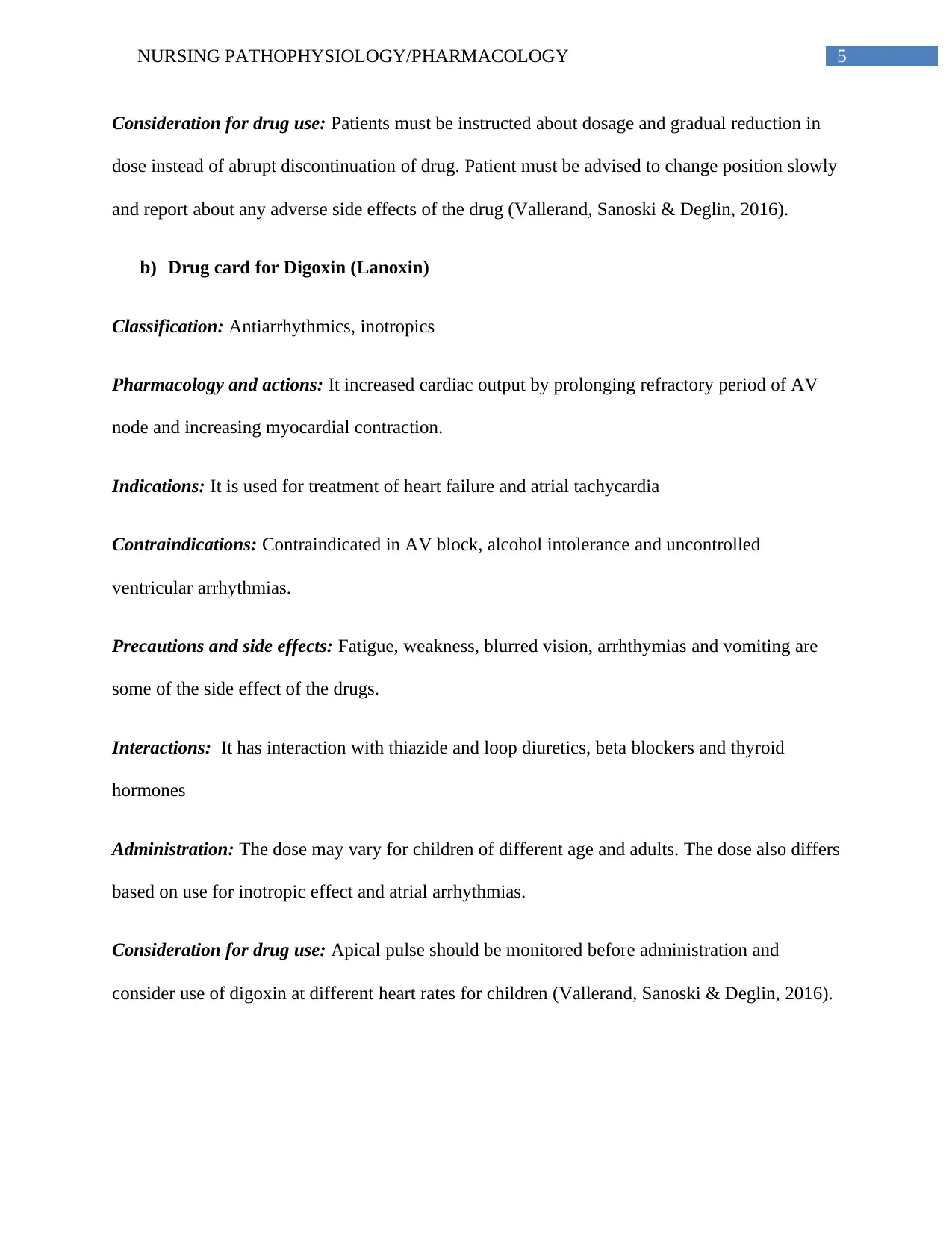
5NURSING PATHOPHYSIOLOGY/PHARMACOLOGY
Consideration for drug use: Patients must be instructed about dosage and gradual reduction in
dose instead of abrupt discontinuation of drug. Patient must be advised to change position slowly
and report about any adverse side effects of the drug (Vallerand, Sanoski & Deglin, 2016).
b) Drug card for Digoxin (Lanoxin)
Classification: Antiarrhythmics, inotropics
Pharmacology and actions: It increased cardiac output by prolonging refractory period of AV
node and increasing myocardial contraction.
Indications: It is used for treatment of heart failure and atrial tachycardia
Contraindications: Contraindicated in AV block, alcohol intolerance and uncontrolled
ventricular arrhythmias.
Precautions and side effects: Fatigue, weakness, blurred vision, arrhthymias and vomiting are
some of the side effect of the drugs.
Interactions: It has interaction with thiazide and loop diuretics, beta blockers and thyroid
hormones
Administration: The dose may vary for children of different age and adults. The dose also differs
based on use for inotropic effect and atrial arrhythmias.
Consideration for drug use: Apical pulse should be monitored before administration and
consider use of digoxin at different heart rates for children (Vallerand, Sanoski & Deglin, 2016).
Consideration for drug use: Patients must be instructed about dosage and gradual reduction in
dose instead of abrupt discontinuation of drug. Patient must be advised to change position slowly
and report about any adverse side effects of the drug (Vallerand, Sanoski & Deglin, 2016).
b) Drug card for Digoxin (Lanoxin)
Classification: Antiarrhythmics, inotropics
Pharmacology and actions: It increased cardiac output by prolonging refractory period of AV
node and increasing myocardial contraction.
Indications: It is used for treatment of heart failure and atrial tachycardia
Contraindications: Contraindicated in AV block, alcohol intolerance and uncontrolled
ventricular arrhythmias.
Precautions and side effects: Fatigue, weakness, blurred vision, arrhthymias and vomiting are
some of the side effect of the drugs.
Interactions: It has interaction with thiazide and loop diuretics, beta blockers and thyroid
hormones
Administration: The dose may vary for children of different age and adults. The dose also differs
based on use for inotropic effect and atrial arrhythmias.
Consideration for drug use: Apical pulse should be monitored before administration and
consider use of digoxin at different heart rates for children (Vallerand, Sanoski & Deglin, 2016).
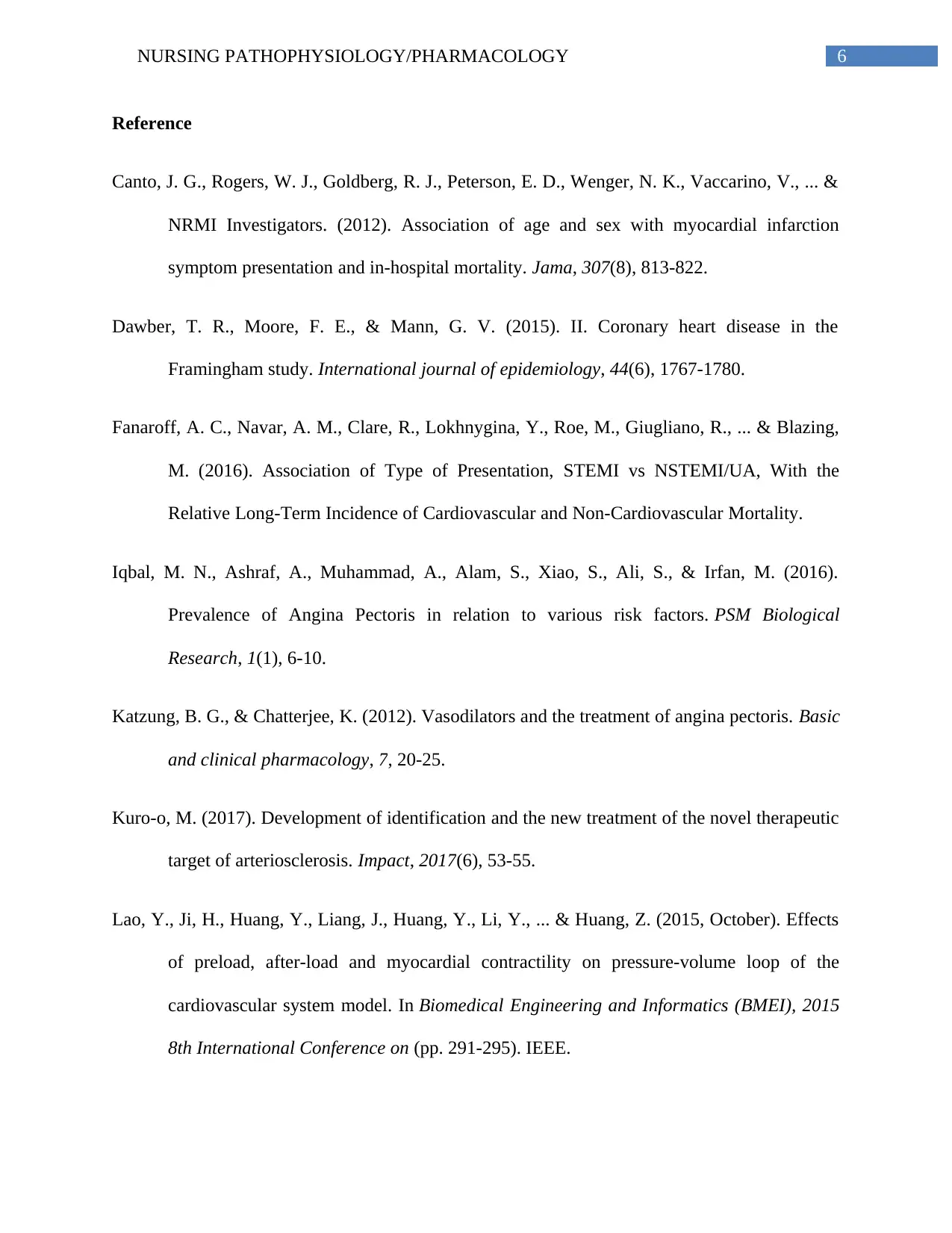
6NURSING PATHOPHYSIOLOGY/PHARMACOLOGY
Reference
Canto, J. G., Rogers, W. J., Goldberg, R. J., Peterson, E. D., Wenger, N. K., Vaccarino, V., ... &
NRMI Investigators. (2012). Association of age and sex with myocardial infarction
symptom presentation and in-hospital mortality. Jama, 307(8), 813-822.
Dawber, T. R., Moore, F. E., & Mann, G. V. (2015). II. Coronary heart disease in the
Framingham study. International journal of epidemiology, 44(6), 1767-1780.
Fanaroff, A. C., Navar, A. M., Clare, R., Lokhnygina, Y., Roe, M., Giugliano, R., ... & Blazing,
M. (2016). Association of Type of Presentation, STEMI vs NSTEMI/UA, With the
Relative Long-Term Incidence of Cardiovascular and Non-Cardiovascular Mortality.
Iqbal, M. N., Ashraf, A., Muhammad, A., Alam, S., Xiao, S., Ali, S., & Irfan, M. (2016).
Prevalence of Angina Pectoris in relation to various risk factors. PSM Biological
Research, 1(1), 6-10.
Katzung, B. G., & Chatterjee, K. (2012). Vasodilators and the treatment of angina pectoris. Basic
and clinical pharmacology, 7, 20-25.
Kuro-o, M. (2017). Development of identification and the new treatment of the novel therapeutic
target of arteriosclerosis. Impact, 2017(6), 53-55.
Lao, Y., Ji, H., Huang, Y., Liang, J., Huang, Y., Li, Y., ... & Huang, Z. (2015, October). Effects
of preload, after-load and myocardial contractility on pressure-volume loop of the
cardiovascular system model. In Biomedical Engineering and Informatics (BMEI), 2015
8th International Conference on (pp. 291-295). IEEE.
Reference
Canto, J. G., Rogers, W. J., Goldberg, R. J., Peterson, E. D., Wenger, N. K., Vaccarino, V., ... &
NRMI Investigators. (2012). Association of age and sex with myocardial infarction
symptom presentation and in-hospital mortality. Jama, 307(8), 813-822.
Dawber, T. R., Moore, F. E., & Mann, G. V. (2015). II. Coronary heart disease in the
Framingham study. International journal of epidemiology, 44(6), 1767-1780.
Fanaroff, A. C., Navar, A. M., Clare, R., Lokhnygina, Y., Roe, M., Giugliano, R., ... & Blazing,
M. (2016). Association of Type of Presentation, STEMI vs NSTEMI/UA, With the
Relative Long-Term Incidence of Cardiovascular and Non-Cardiovascular Mortality.
Iqbal, M. N., Ashraf, A., Muhammad, A., Alam, S., Xiao, S., Ali, S., & Irfan, M. (2016).
Prevalence of Angina Pectoris in relation to various risk factors. PSM Biological
Research, 1(1), 6-10.
Katzung, B. G., & Chatterjee, K. (2012). Vasodilators and the treatment of angina pectoris. Basic
and clinical pharmacology, 7, 20-25.
Kuro-o, M. (2017). Development of identification and the new treatment of the novel therapeutic
target of arteriosclerosis. Impact, 2017(6), 53-55.
Lao, Y., Ji, H., Huang, Y., Liang, J., Huang, Y., Li, Y., ... & Huang, Z. (2015, October). Effects
of preload, after-load and myocardial contractility on pressure-volume loop of the
cardiovascular system model. In Biomedical Engineering and Informatics (BMEI), 2015
8th International Conference on (pp. 291-295). IEEE.
Paraphrase This Document
Need a fresh take? Get an instant paraphrase of this document with our AI Paraphraser
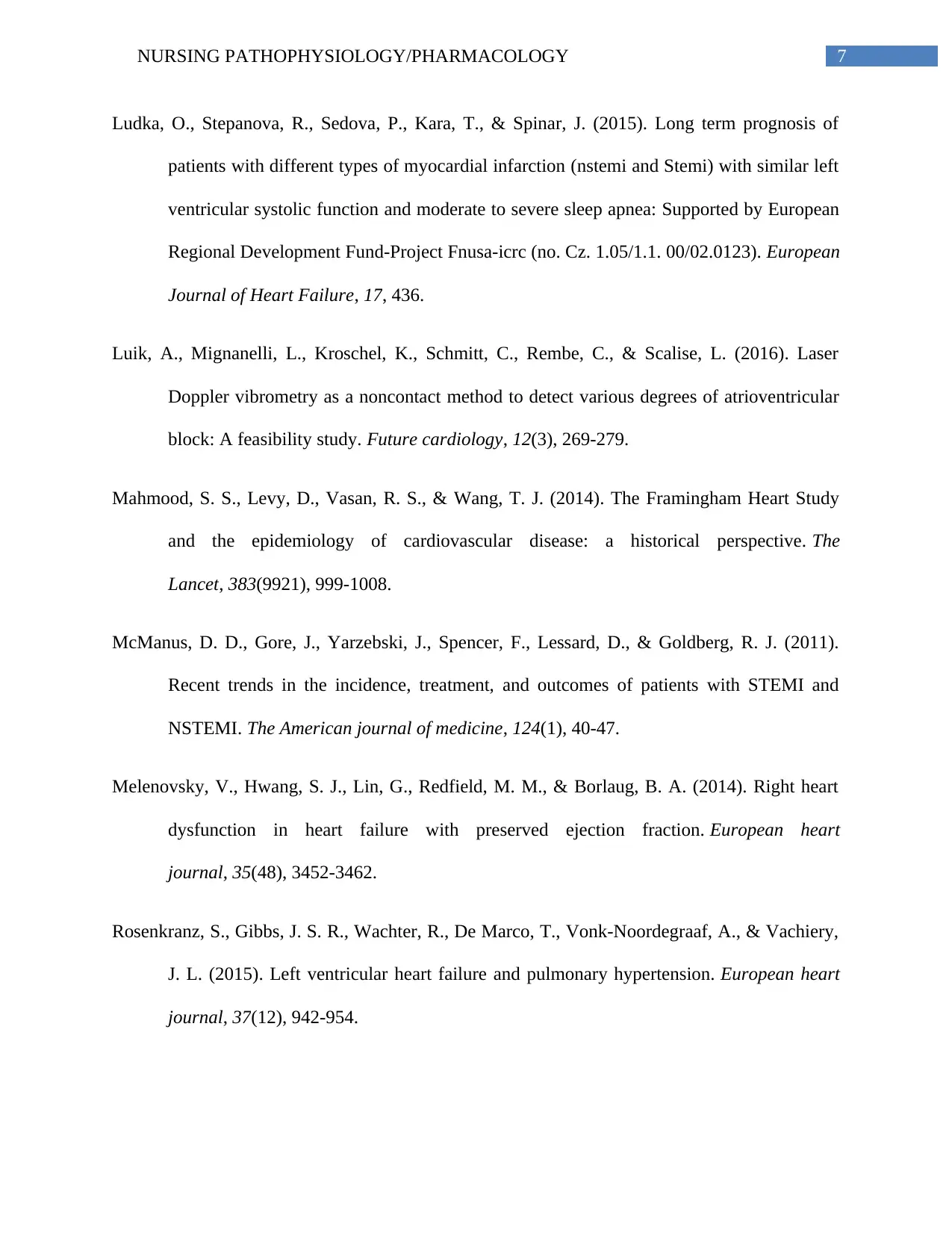
7NURSING PATHOPHYSIOLOGY/PHARMACOLOGY
Ludka, O., Stepanova, R., Sedova, P., Kara, T., & Spinar, J. (2015). Long term prognosis of
patients with different types of myocardial infarction (nstemi and Stemi) with similar left
ventricular systolic function and moderate to severe sleep apnea: Supported by European
Regional Development Fund-Project Fnusa-icrc (no. Cz. 1.05/1.1. 00/02.0123). European
Journal of Heart Failure, 17, 436.
Luik, A., Mignanelli, L., Kroschel, K., Schmitt, C., Rembe, C., & Scalise, L. (2016). Laser
Doppler vibrometry as a noncontact method to detect various degrees of atrioventricular
block: A feasibility study. Future cardiology, 12(3), 269-279.
Mahmood, S. S., Levy, D., Vasan, R. S., & Wang, T. J. (2014). The Framingham Heart Study
and the epidemiology of cardiovascular disease: a historical perspective. The
Lancet, 383(9921), 999-1008.
McManus, D. D., Gore, J., Yarzebski, J., Spencer, F., Lessard, D., & Goldberg, R. J. (2011).
Recent trends in the incidence, treatment, and outcomes of patients with STEMI and
NSTEMI. The American journal of medicine, 124(1), 40-47.
Melenovsky, V., Hwang, S. J., Lin, G., Redfield, M. M., & Borlaug, B. A. (2014). Right heart
dysfunction in heart failure with preserved ejection fraction. European heart
journal, 35(48), 3452-3462.
Rosenkranz, S., Gibbs, J. S. R., Wachter, R., De Marco, T., Vonk-Noordegraaf, A., & Vachiery,
J. L. (2015). Left ventricular heart failure and pulmonary hypertension. European heart
journal, 37(12), 942-954.
Ludka, O., Stepanova, R., Sedova, P., Kara, T., & Spinar, J. (2015). Long term prognosis of
patients with different types of myocardial infarction (nstemi and Stemi) with similar left
ventricular systolic function and moderate to severe sleep apnea: Supported by European
Regional Development Fund-Project Fnusa-icrc (no. Cz. 1.05/1.1. 00/02.0123). European
Journal of Heart Failure, 17, 436.
Luik, A., Mignanelli, L., Kroschel, K., Schmitt, C., Rembe, C., & Scalise, L. (2016). Laser
Doppler vibrometry as a noncontact method to detect various degrees of atrioventricular
block: A feasibility study. Future cardiology, 12(3), 269-279.
Mahmood, S. S., Levy, D., Vasan, R. S., & Wang, T. J. (2014). The Framingham Heart Study
and the epidemiology of cardiovascular disease: a historical perspective. The
Lancet, 383(9921), 999-1008.
McManus, D. D., Gore, J., Yarzebski, J., Spencer, F., Lessard, D., & Goldberg, R. J. (2011).
Recent trends in the incidence, treatment, and outcomes of patients with STEMI and
NSTEMI. The American journal of medicine, 124(1), 40-47.
Melenovsky, V., Hwang, S. J., Lin, G., Redfield, M. M., & Borlaug, B. A. (2014). Right heart
dysfunction in heart failure with preserved ejection fraction. European heart
journal, 35(48), 3452-3462.
Rosenkranz, S., Gibbs, J. S. R., Wachter, R., De Marco, T., Vonk-Noordegraaf, A., & Vachiery,
J. L. (2015). Left ventricular heart failure and pulmonary hypertension. European heart
journal, 37(12), 942-954.
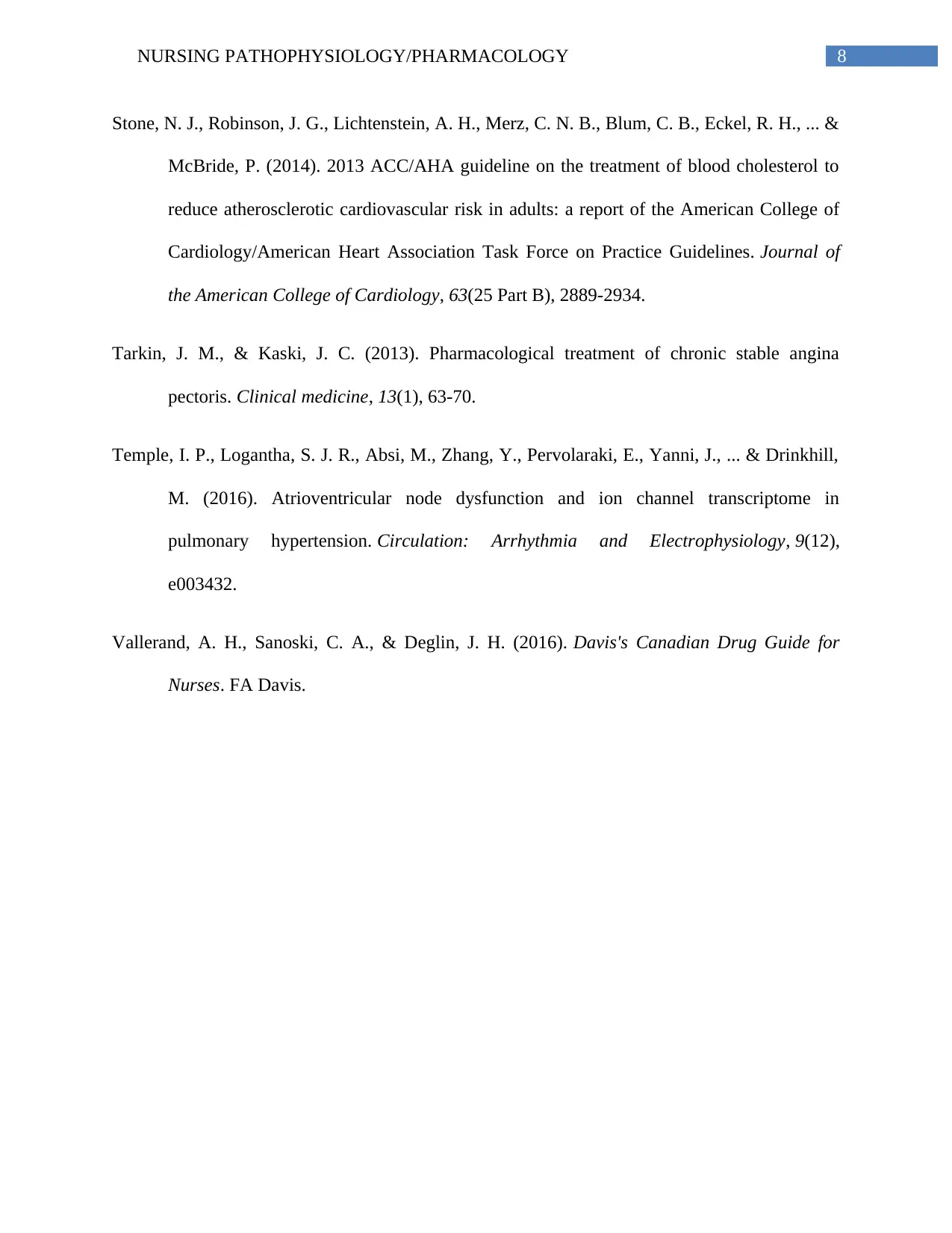
8NURSING PATHOPHYSIOLOGY/PHARMACOLOGY
Stone, N. J., Robinson, J. G., Lichtenstein, A. H., Merz, C. N. B., Blum, C. B., Eckel, R. H., ... &
McBride, P. (2014). 2013 ACC/AHA guideline on the treatment of blood cholesterol to
reduce atherosclerotic cardiovascular risk in adults: a report of the American College of
Cardiology/American Heart Association Task Force on Practice Guidelines. Journal of
the American College of Cardiology, 63(25 Part B), 2889-2934.
Tarkin, J. M., & Kaski, J. C. (2013). Pharmacological treatment of chronic stable angina
pectoris. Clinical medicine, 13(1), 63-70.
Temple, I. P., Logantha, S. J. R., Absi, M., Zhang, Y., Pervolaraki, E., Yanni, J., ... & Drinkhill,
M. (2016). Atrioventricular node dysfunction and ion channel transcriptome in
pulmonary hypertension. Circulation: Arrhythmia and Electrophysiology, 9(12),
e003432.
Vallerand, A. H., Sanoski, C. A., & Deglin, J. H. (2016). Davis's Canadian Drug Guide for
Nurses. FA Davis.
Stone, N. J., Robinson, J. G., Lichtenstein, A. H., Merz, C. N. B., Blum, C. B., Eckel, R. H., ... &
McBride, P. (2014). 2013 ACC/AHA guideline on the treatment of blood cholesterol to
reduce atherosclerotic cardiovascular risk in adults: a report of the American College of
Cardiology/American Heart Association Task Force on Practice Guidelines. Journal of
the American College of Cardiology, 63(25 Part B), 2889-2934.
Tarkin, J. M., & Kaski, J. C. (2013). Pharmacological treatment of chronic stable angina
pectoris. Clinical medicine, 13(1), 63-70.
Temple, I. P., Logantha, S. J. R., Absi, M., Zhang, Y., Pervolaraki, E., Yanni, J., ... & Drinkhill,
M. (2016). Atrioventricular node dysfunction and ion channel transcriptome in
pulmonary hypertension. Circulation: Arrhythmia and Electrophysiology, 9(12),
e003432.
Vallerand, A. H., Sanoski, C. A., & Deglin, J. H. (2016). Davis's Canadian Drug Guide for
Nurses. FA Davis.
1 out of 9
Related Documents
Your All-in-One AI-Powered Toolkit for Academic Success.
+13062052269
info@desklib.com
Available 24*7 on WhatsApp / Email
![[object Object]](/_next/static/media/star-bottom.7253800d.svg)
Unlock your academic potential
© 2024 | Zucol Services PVT LTD | All rights reserved.





